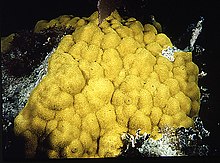|
Ladder Bay (Saba)
Ladder Bay is an anchorage on the leeward side of the Caribbean island of Saba. The bay sits on the west side of the island, directly under a set of 800 steps hand carved into the rocks locally known as "The Ladder".[2][3] Until the construction of Saba's first pier in the 1970s, Ladder Bay was a primary point of entry for supplies to the island.[4][3][5] An abandoned customs house sits on the lip of a cliff overlooking the bay.[6][7] HistoryBefore European colonization, the area above Ladder Bay may have been occupied by Amerindians during the Ceramic Era.[8] Archeologists have not yet found evidence of an Amerindian settlement above Ladder Bay, but they have found ceramic artifacts in the area.[8] Saba was settled by Europeans in the mid-17th century.[9] There is long-standing documentation of early European settlements near Tent Bay, Fort Bay, and above Well's Bay.[9][10] But more recently, archeologists have found 17th-century ceramics above Ladder Bay, suggesting the area may have been occupied during early years of European settlement.[8] From the 1650s until the 1970s, the two primary ports of entry for Saba were at Ladder Bay and Fort Bay.[11] Boats could offload cargo at Ladder Bay, which would then be transported up "The Ladder", a series of steps carved into the ridge above Ladder Bay.[2][9] The cargo would then be transported to Saba's capital, The Bottom, via a footpath through an area known as The Gap.[2] Both cargo and people were brought onto Saba via The Ladder.[2][9][10] Even large items were transported up The Ladder, one of the most famous being a piano.[2][12][13] In the 1930s, The Ladder in its current form, as well as the Customs House, were constructed.[2][9] The steps of The Ladder were made of poured concrete, and the staircase walls from a mixture of concrete and rock.[2] In the 1970s, the Capt. Chance Leo Pier was constructed at Fort Bay. With a harbor at Fort Bay, the use of Ladder Bay as a port fell out of use.[14] In 2017, the bottom 2 meters (6.5 ft) of The Ladder were severely damaged by Hurricane Maria. Today, "The Ladder" is an iconic Saban monument[2][15] and popular hiking location,[16][17] and Ladder Bay is an official mooring area[18] and the site of multiple popular dive sites.[19] HikingThe Ladder (Trail): The trailhead is located between The Bottom and Well's Bay.[17] The trail goes past the old customs house, and descends all 800 steps of The Ladder, before coming back up. The strenuous hike takes about 1 hour round trip.[17][20] The dry forest[21] portion of the trail includes diverse trees, including mahogany trees (e.g. Swietenia mahagoni) and cinnamon trees (Pimenta racemosa).[22] Middle Island Trail: The trail begins close to The Ladder trail, and has views of Well's Bay and Ladder Bay.[23] It is a heritage trail that includes ruins of an open cistern, stone walls of a farm, and a cavern. The hike takes about 40 minutes one-way.[24] Diving Ladder Bay is the location of multiple dive sites for scuba divers.[19]
At Babylon, Ladder Labyrinth, and 50/50, divers can place their hands on hot, sulfur-colored sand, resulting from the active status of Saba's volcano.[30][26][27][29] Marine life The bay is home to a variety of fish, including Burrfish, Chromis, Filefish, Glassy Sweepers, Horse-eye Jacks, Lancer Dragonets, Lizardfish, Peacock Flounders, Pikeblennies, Schoolmasters, Spotted Drums, Tarpons, Yellowfin Groupers, and Yellowhead Jawfish, as well as Nurse Sharks and Reef sharks.[25][26][27][29] Other marine life in Ladder Bay includes Channel Clinging Crabs, Green Turtles, Hawksbill Turtles, Spotted Moray Eels, Squat Lobster, and Tigertail Sea Cucumber.[25][26][27][29] Ladder Bay's reefs include a variety of coral. The most common are Star coral (Astreopora), Brain coral, and Gorgonian (Alcyonacea) coral,[25] as well as Porites coral at the Porites Point dive site.[25] The bay is also home to sea fans such as Deepwater Seafans.[26] MooringsSaba has two designated anchorage zones within the Saba National Marine Park: one between Ladder Bay and Wells Bay (west coast),[18] and one in front of Fort Bay (southern coast).[18] Between Ladder Bay and Wells Bay, the Saba National Marine Park manages about half a dozen moorings[31] that are in about 60 feet (18 m) of water. The use of mooring buoys can help eliminator anchor damage to coral reefs.[18][32][33] Passengers of moored boats are advised to enter the island via through Fort Bay Harbor for safety reasons.[18][34] Additionally, passengers from arriving yachts are required to go to Fort Bay to clear Customs and Immigration, as well as to check in and out with the Saba's Harbor Master.[34] In March 2017, a French-owned boat broke free of its mooring, and became stranded on the rocks in Ladder Bay. No one was aboard, and the boat was successfully salvaged a few days later.[35][36] That same year another vessel ran aground at Ladder Bay; all passengers were unharmed.[37] In April 2023, a mooring holding a French charter boat broke off during the night while the crew was asleep. [citation needed] The crew was alerted and safely re-anchored, but only two visitor moorings remain. [citation needed] See alsoReferences
External links |
||||||||||||||||||||||
Portal di Ensiklopedia Dunia

